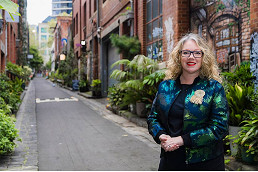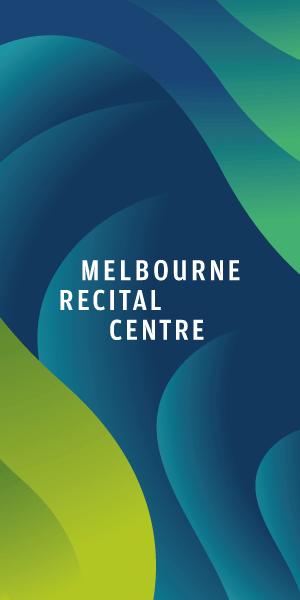The Lamb Inn, a “roystering place for shepherds with cheques”, c. 1840
Tucked away in the bottom right-hand corner of this watercolour by W F E Liardet are two small windblown figures battling Melbourne’s notorious north-westerly winds.
One is buying something at the coffee and tea building, an early follower of our coffee culture, perhaps? The other is valiantly hanging on to what could be a newspaper or a map.
In front of them, along Flinders St and the Yarra River, is a busy port scene. This was known as the Landing Place. Several boats are pulled up off the river. A sailing ship, masts down, is docked in the foreground.
Moving into the scene from the west is a large rowing boat, the crew dressed in naval uniforms. Top-hatted passengers sit at the front, their portly figures suggesting they are men of substance in more ways than one.
Along the street, barrels of sherry and port are moved from a wattle-and-daub warehouse onto a cart and further down the street a cart heads east loaded with sacks – of feed, perhaps.
Centre stage in the background is the Lamb Inn with billiards hall on its right. It has an uninterrupted view down the hill, past the cleared market reserve, to a busy port scene in the fledgling Port Phillip settlement.
Within a year, the Western Market (think Market St) was built, the view had gone and the Lamb was struggling. It survived, eventually becoming Scott’s Hotel (444 Collins St), and re-established itself as a Melbourne institution.
At the time depicted here, the Lamb Inn was only a few years old and had already become an important hub of activity, a “roystering place for shepherds with cheques”, according to the Encyclopedia of Melbourne.
It was here that the Melbourne Club and the Melbourne Cricket Club held their first meetings and the first of Melbourne’s race meetings was organised. It was here, too, that a public meeting was held to ask the government to establish civil and criminal courts in the province.
And it was here on New Year’s Day 1838 that the first mail service between Melbourne and Sydney set off. Considered a dangerous mission with every likelihood of failure, it attracted a large crowd who cheered as the mail carrier, a young Irishman named John Bourke, set off with two leather bags of mail, dressed in a leather suit, a wide sombrero on his head and a pair of duelling pistols in his belt.
He took with him provisions for the long journey – food, camping equipment and other essentials.
And yes, he made it to Yass where his NSW counterpart took over and was back in Melbourne within a fortnight. •

Could the Metro Tunnel help Melbourne rediscover its mojo?






 Download the Latest Edition
Download the Latest Edition